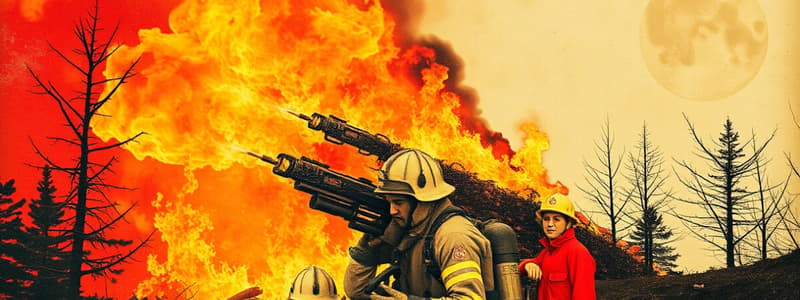Podcast
Questions and Answers
What is primarily aimed at stabilizing fire conditions during an initial attack?
What is primarily aimed at stabilizing fire conditions during an initial attack?
- Applying water from a distance
- Using the least amount of water possible
- Executing an aggressive, well-placed fire attack (correct)
- Waiting for conditions to improve
When should a transitional attack be considered?
When should a transitional attack be considered?
- When water supply is insufficient for interior application
- When conditions require internal changes before entry (correct)
- Only when the fire is out of control
- When it is most effective to fight fire from the inside out
Which factor is least relevant when determining water application during a fire attack?
Which factor is least relevant when determining water application during a fire attack?
- Structure/compartment size
- Temperature outside the building (correct)
- Extent of fire conditions
- Heat release rate of the fire
What must a fire attack utilize to effectively control the fire and protect victims?
What must a fire attack utilize to effectively control the fire and protect victims?
What is the primary goal of an aggressive fire attack?
What is the primary goal of an aggressive fire attack?
What is the main purpose of a transitional attack during a fire response?
What is the main purpose of a transitional attack during a fire response?
Which of the following is NOT a key consideration in applying water during a fire attack?
Which of the following is NOT a key consideration in applying water during a fire attack?
During an aggressive fire attack, which approach is considered most advantageous for effective suppression?
During an aggressive fire attack, which approach is considered most advantageous for effective suppression?
What is the primary aim of utilizing adequate water volume in a fire attack?
What is the primary aim of utilizing adequate water volume in a fire attack?
In which scenario would it be most appropriate to perform an initial fire attack from the exterior?
In which scenario would it be most appropriate to perform an initial fire attack from the exterior?
Flashcards are hidden until you start studying
Study Notes
Fire Attack Procedure
- Standard operating procedure emphasizes aggressive fire attack to stabilize conditions.
- Initial attack strategies should strive to overwhelm fire with effective water application.
- Fire attack angles can be taken from interior, exterior, or through transitional methods.
Transitional Attack
- A transitional attack is recommended when circumstances necessitate changing the fighting approach from external to internal.
- This tactic aims to manage fire conditions before entering a structure.
Water Application
- Firefighting must involve sufficient water volume, measured in gallons per minute (gpm).
- Water volume must correspond with fire conditions, heat release rates, and the size of the structure or compartment.
Objectives of Fire Attack
- The primary goals of fire attack include controlling the fire, safeguarding victims, and protecting property.
- Effective fire management also seeks to prevent fire extension into adjacent or exposed structures.
Fire Attack Procedures
- Standard practice involves stabilizing fire conditions through aggressive, targeted fire attack strategies.
- Initial attack should focus on overwhelming fire conditions with precise water application and suppression methods.
- Attack positions can be categorized as:
- Interior: Fighting fire from inside the structure.
- Exterior: Suppressing fire from outside the building.
- Transitional: Changing tactics from exterior to interior when needed.
- Transitional attacks are essential when fire is being passed or when conditions require exterior changes before entry.
- Application of water must be sufficient in volume (gallons per minute) to effectively manage:
- Current fire conditions.
- Heat release rates.
- Size and layout of the structure or compartment.
- Objectives of the fire attack include:
- Controlling the fire.
- Protecting victims and property.
- Preventing fire spread to adjoining structures.
Studying That Suits You
Use AI to generate personalized quizzes and flashcards to suit your learning preferences.




